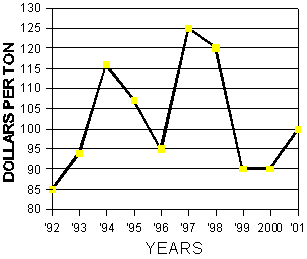Alfalfa Report
Yuma County, Arizona
January 29, 2001
Yuma County Office
2200 W. 28th Street, Ste. 102
Yuma, AZ 85364
(520) 726-3904
(520) 726-8472 FAX
Production Update:
PDF version, 14KB
Forage Testing: Forage quality can be evaluated by certified laboratories by testing for various quality components. A forage quality analysis typically includes dry matter, crude protein, acid detergent fiber (ADF), and neutral detergent fiber (NDF). Hay quality standards can be based on quality components such as ADF. Many growers rely on hay brokers or dairymen to tell them the quality of their hay. The cost of a hay quality analysis is about $20 to $30 per sample, and this information in the hands of the producer can help leverage a sale in their favor.
Insect Management: Egyptian alfalfa weevil populations are building in hay fields. The first management step is to sample alfalfa fields every 2 to 4 days after weevil larvae first appear. Sample each field quadrant by taking 5 sweeps with a standard net. Count the number of weevil larvae in each 5 sweep sample and add the totals for each of the field quadrants. Divide the grand total for the field by the total number of sweeps (20). The field should be treated with an insecticide registered for weevil control when the average number of larvae reaches or exceeds 20 per sweep. If sweep counts are 10 to 15 larvae per sweep just before cutting, then applying malathion under the windrows may be considered. Stubble treatments are another option. Aphids and alfalfa weevils can be controlled for a few weeks with an application of Pounce 3.2 EC plus Furadan 4 F immediately after hay bale removal.
Weed Control: When alfalfa is planted in the spring, the competitive
edge goes to the weeds. Summer annual and perennial weeds can tolerate
harsh summer conditions while it is a struggle for seedling alfalfa with
not much of a root system yet developed. It is far better to plant alfalfa
in the fall when it has time to become well established before summer.
| Market Summary |
High
|
Low
|
Average
|
Off grade
|
| Past 2 Weeks (Jan. 16 to Jan. 29, 2001) |
105
|
95
|
100
|
70-90
|
| Last Year (Jan. 16 to Jan. 29, 2000) |
100
|
80
|
90
|
45-80
|
10 Year Summary (January 16, to January 29, 1992-2001):

Issued in furtherance of Cooperative Extension work, acts of May 8 and June 30, 1914, in cooperation with the U.S. Department of Agriculture, James A. Christenson, Director Cooperative Extension, College of Agriculture and Life Sciences, The University of Arizona.
The University of Arizona is an equal opportunity, affirmative action institution. The University does not discriminate on the basis of race, color, religion, sex, national origin, age, disability, veteran status, or sexual orientation in its programs and activities.
Any products, services, or organizations that are
mentioned, shown, or indirectly implied in this web document do not imply
endorsement by The University of Arizona.
Information provided by:
Barry Tickes, btickes@ag.arizona.edu Extension Agent, Yuma County
Michael Ottman, mottman@ag.arizona.edu Agronomy Specialist
College of Agriculture, The University of Arizona.
Eric Natwick, etnatwick@ucdavis.edu UCCE Imperial County - Farm Advisor
University of California, Davis, CA.
Material written January 29, 2001.
Forages: Crop Mgmt | Soil Mgmt | Irrigation | Alfalfa Reports | Insects | Diseases | Weeds | Pesticides
Home | Other Crops | Forages
For more Arizona Production Ag Information:
Home | Cotton | Veggies| Forages | Grains | Citrus | Crop x Crop | Insects | Diseases| Weeds | Pesticides | News | Weather | Research | Photos | Contacts | General Info. | Site Map
Copyright © 2001 University of Arizona,
College of Agriculture and Life Sciences
Webmaster: Al Fournier (fournier@ag.arizona.edu)